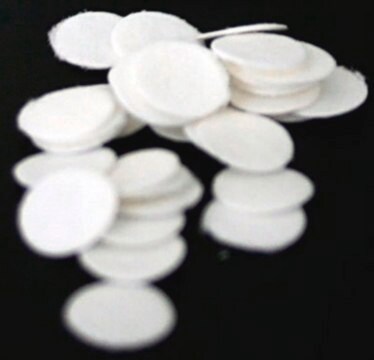63367
Dextrose Disks
suitable for microbiology, Sterile filter paper discs impregnated with dextrose
Sinonimo/i:
Carbohydrate discs
About This Item
Prodotti consigliati
Livello qualitativo
Sterilità
sterile
Nome Commerciale
BioChemika
Durata
limited shelf life, expiry date on the label
Confezionamento
pkg of 10 × 25 discs
tecniche
microbe id | utilization test: suitable
applicazioni
clinical testing
environmental
food and beverages
pharmaceutical
microbiology
Temperatura di conservazione
2-8°C
Compatibilità
Citrobacter spp.
Enterobacter spp.
Escherichia coli
Klebsiella spp.
Neisseria spp.
Proteus spp.
Salmonella spp.
Serratia spp.
Shigella spp.
Streptococcus spp.
bacteria
Descrizione generale
Applicazioni
Codice della classe di stoccaggio
11 - Combustible Solids
Classe di pericolosità dell'acqua (WGK)
WGK 3
Punto d’infiammabilità (°F)
Not applicable
Punto d’infiammabilità (°C)
Not applicable
Dispositivi di protezione individuale
Eyeshields, Gloves, type N95 (US)
Scegli una delle versioni più recenti:
Possiedi già questo prodotto?
I documenti relativi ai prodotti acquistati recentemente sono disponibili nell’Archivio dei documenti.
Articoli
Sigma-Aldrich.com presents an article concerning Differentiation of Escherichia coli from coliforms.
Salmonella contamination is the second leading cause of food-borne illness worldwide. Controlling outbreaks of Salmonella is an important task for food regulators, restaurants and the food industry in general. The Salmonella family includes over 2,300 serotypes of bacteria, but two types, Salmonella enteritidis and Salmonella typhimurium, are responsible for about half of all human infections. Most outbreaks of Salmonella are traced back to dairy, poultry and meat products, but Salmonella can grow on nearly any food. Chicken, eggs and their derivative products are particularly high risk.
Il team dei nostri ricercatori vanta grande esperienza in tutte le aree della ricerca quali Life Science, scienza dei materiali, sintesi chimica, cromatografia, discipline analitiche, ecc..
Contatta l'Assistenza Tecnica.

